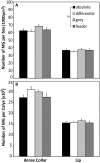Does Fine Color Discrimination Learning in Free-Flying Honeybees Change Mushroom-Body Calyx Neuroarchitecture?
- PMID: 27783640
- PMCID: PMC5081207
- DOI: 10.1371/journal.pone.0164386
Does Fine Color Discrimination Learning in Free-Flying Honeybees Change Mushroom-Body Calyx Neuroarchitecture?
Abstract
Honeybees learn color information of rewarding flowers and recall these memories in future decisions. For fine color discrimination, bees require differential conditioning with a concurrent presentation of target and distractor stimuli to form a long-term memory. Here we investigated whether the long-term storage of color information shapes the neural network of microglomeruli in the mushroom body calyces and if this depends on the type of conditioning. Free-flying honeybees were individually trained to a pair of perceptually similar colors in either absolute conditioning towards one of the colors or in differential conditioning with both colors. Subsequently, bees of either conditioning groups were tested in non-rewarded discrimination tests with the two colors. Only bees trained with differential conditioning preferred the previously learned color, whereas bees of the absolute conditioning group, and a stimuli-naïve group, chose randomly among color stimuli. All bees were then kept individually for three days in the dark to allow for complete long-term memory formation. Whole-mount immunostaining was subsequently used to quantify variation of microglomeruli number and density in the mushroom-body lip and collar. We found no significant differences among groups in neuropil volumes and total microglomeruli numbers, but learning performance was negatively correlated with microglomeruli density in the absolute conditioning group. Based on these findings we aim to promote future research approaches combining behaviorally relevant color learning tests in honeybees under free-flight conditions with neuroimaging analysis; we also discuss possible limitations of this approach.
Conflict of interest statement
The authors have declared that no competing interests exist.
Figures






Similar articles
-
Conditioning procedure and color discrimination in the honeybee Apis mellifera.Naturwissenschaften. 2004 May;91(5):228-31. doi: 10.1007/s00114-004-0530-z. Epub 2004 Apr 23. Naturwissenschaften. 2004. PMID: 15146270
-
Color Difference and Memory Recall in Free-Flying Honeybees: Forget the Hard Problem.Insects. 2014 Jul 30;5(3):629-38. doi: 10.3390/insects5030629. Insects. 2014. PMID: 26462830 Free PMC article.
-
Volume and density of microglomeruli in the honey bee mushroom bodies do not predict performance on a foraging task.Dev Neurobiol. 2017 Sep;77(9):1057-1071. doi: 10.1002/dneu.22492. Epub 2017 Mar 20. Dev Neurobiol. 2017. PMID: 28245532
-
Invertebrate memory: honeybees with a sense of déjà vu.Curr Biol. 2005 Jun 7;15(11):R419-21. doi: 10.1016/j.cub.2005.05.033. Curr Biol. 2005. PMID: 15936262 Review.
-
Cognitive components of color vision in honey bees: how conditioning variables modulate color learning and discrimination.J Comp Physiol A Neuroethol Sens Neural Behav Physiol. 2014 Jun;200(6):449-61. doi: 10.1007/s00359-014-0909-z. Epub 2014 May 1. J Comp Physiol A Neuroethol Sens Neural Behav Physiol. 2014. PMID: 24788332 Review.
Cited by
-
The Role of Celestial Compass Information in Cataglyphis Ants during Learning Walks and for Neuroplasticity in the Central Complex and Mushroom Bodies.Front Behav Neurosci. 2017 Nov 14;11:226. doi: 10.3389/fnbeh.2017.00226. eCollection 2017. Front Behav Neurosci. 2017. PMID: 29184487 Free PMC article.
-
Changing How Biologists View Flowers-Color as a Perception Not a Trait.Front Plant Sci. 2020 Nov 19;11:601700. doi: 10.3389/fpls.2020.601700. eCollection 2020. Front Plant Sci. 2020. PMID: 33329670 Free PMC article.
-
Automated quantification of synaptic boutons reveals their 3D distribution in the honey bee mushroom body.Sci Rep. 2019 Dec 18;9(1):19322. doi: 10.1038/s41598-019-55974-2. Sci Rep. 2019. PMID: 31852957 Free PMC article.
-
Immediate early genes in social insects: a tool to identify brain regions involved in complex behaviors and molecular processes underlying neuroplasticity.Cell Mol Life Sci. 2019 Feb;76(4):637-651. doi: 10.1007/s00018-018-2948-z. Epub 2018 Oct 22. Cell Mol Life Sci. 2019. PMID: 30349993 Free PMC article. Review.
-
Pitfalls of using confocal-microscopy based automated quantification of synaptic complexes in honeybee mushroom bodies (response to Peng and Yang 2016).Sci Rep. 2017 Aug 29;7(1):9786. doi: 10.1038/s41598-017-09967-8. Sci Rep. 2017. PMID: 28852015 Free PMC article.
References
-
- Proctor MCF, Yeo P. The pollination of flowers. New York: Taplinger Pub; 1972.
-
- Barth FG. Insects and flowers: the biology of a partnership. Princeton: Princeton University Press; 1985.
MeSH terms
LinkOut - more resources
Full Text Sources
Other Literature Sources

